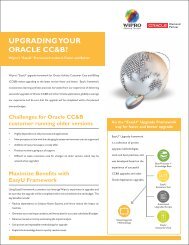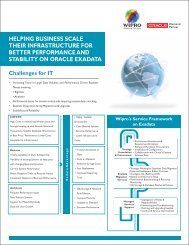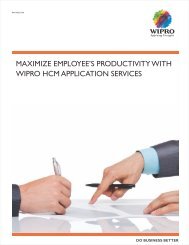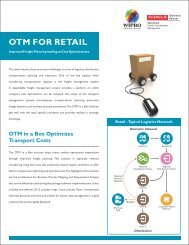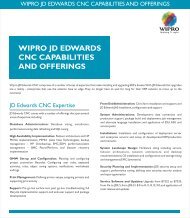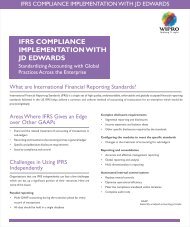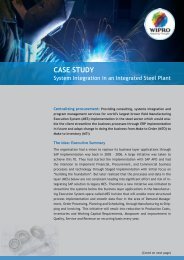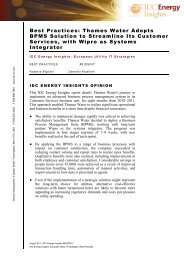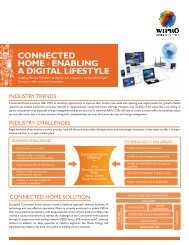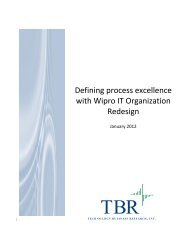ANALYTICS CUT LABOR PAINS IN BIRTHING NEW HIGH-TECH ...
ANALYTICS CUT LABOR PAINS IN BIRTHING NEW HIGH-TECH ...
ANALYTICS CUT LABOR PAINS IN BIRTHING NEW HIGH-TECH ...
You also want an ePaper? Increase the reach of your titles
YUMPU automatically turns print PDFs into web optimized ePapers that Google loves.
Point of View - AIM Practice - Advanced Analytics<br />
<strong>ANALYTICS</strong> <strong>CUT</strong> <strong>LABOR</strong> <strong>PA<strong>IN</strong>S</strong> <strong>IN</strong><br />
BIRTH<strong>IN</strong>G <strong>NEW</strong> <strong>HIGH</strong>-<strong>TECH</strong> PRODUCTS<br />
WWW.WIPRO.COM<br />
F. A. Lambay<br />
CPIM, CSCP, CPF
Point of View - AIM Practice - Advanced Analytics<br />
Analytics cut labor pains in birthing new high-tech<br />
products is all about managing product life cycles by<br />
enhancing sales and operational planning process which<br />
helps all companies in gaining market share early on<br />
competition.<br />
WWW.WIPRO.COM<br />
F. A. Lambay<br />
CPIM, CSCP, CPF
Table of Contents<br />
High-tech Uses Analytics in New PLM Strategy 4<br />
Birthing a New High-tech Product 5<br />
S&OP Focus with NPI & EOL Transition 5<br />
Responsive Sub-processes in the New Proactive Model 6<br />
Analytical Mindset to Measure Process Maturity 7<br />
Conclusion 8
The high tech industry was witnessing shortened product life cycles and technology cycles, though decision-makers in the supply chain were still<br />
unwilling to meet the level of collaboration desired in an ideal customer-supplier relationship. It became extremely difficult to forecast new<br />
product introductions (NPI) from both, siloed business stakeholders and no previous history existing of similar or like products. At the same time<br />
slow moving inventory in the pipeline got stranded (refer tabulated column values – quantity on hand after consumption and liability) as the old<br />
product's demand, nearing end of life (EOL), had eroded. To succeed would require reassessment of supply chain variables such as batch sizes,<br />
economic order quantities (EOQs), minimum order quantities (MOQs), lead times, and the like, to couple with an enhanced Sales & Operational<br />
Planning (S&OP) Process in responding to the rapidly adapting needs of the market place and changing tastes and preferences of the customers.<br />
(refer analytical model output below).<br />
Customer Assembly Type Component Description Qty On Ext STD Total LTB Demand Inventory Covers Total Qty On- Liability On Hand Assume<br />
Description Hand Demand Qty Total LTB Demand Hand After Dock<br />
Consumption<br />
ABC, inc Assy OVRLY, DMSCS 185 $6.78 320 200 No (22) $ - 178<br />
ABC, inc SubAssy ATCA-Single Blade 154 $57.89 320 200 No (44) $ - 156<br />
ABC, inc SubAssy IC-VLS 175 $26.92 320 200 No (18) $ - 182<br />
ABC, inc SubAssy ZD PLUG, 40 PAIR 639 $78.96 640 400 Yes 239 $ 9,435.18 639<br />
ABC, inc SubAssy SRAM, Kx16 3,557 $4.82 320 200 Yes 3,357 $ 16,357.29 3557<br />
ABC, inc SubAssy SOP, TP-PWP 6,920 $4.53 320 200 Yes 6,720 $ 30,882.12 6920<br />
ABC, inc SubAssy CHIP 3.9A 1,487 $1.63 320 200 Yes 1,287 $ 1,346.24 1487<br />
ABC, inc Assy GASKET 659 $5.38 320 200 Yes 459 $ 2,296.98 659<br />
ABC, inc Assy FRONT PANEL, ASSY 365 $54.68 320 200 Yes 147 $ 8,342.28 347<br />
ABC, inc Assy BRACKET, HDD 370 $21.78 320 200 Yes 174 $ 3,609.10 374<br />
ABC, inc Assy PANEL, AIR BAFFLE 465 $30.47 320 200 Yes 246 $ 7,261.19 447<br />
ABC, inc SubAssy CONN, SAS X4 2,064 $16,23 320 200 Yes 1,740 $ 27,667.53 1941<br />
ABC, inc Assy HEATS<strong>IN</strong>K 2,419 $10.24 320 200 Yes 2,267 $ 25,495.42 2468<br />
Collaborating all supply chain partners to facilitate timely product<br />
innovation, would minimize total costs, gain quick market share and<br />
competitive advantage. This white paper discusses a new analytical<br />
model with pre-launch preparations, tactical planning, and product<br />
life cycle management that could be applied as standard work in any<br />
industry wanting to target inventory problems from a combination<br />
of obsolete products with no demand and residual finished goods<br />
with leftover components. Benefits realized by implementing this<br />
enhanced S&OP process integrated with Product Lifecycle<br />
Management (PLM) and EOL transition planning would translate<br />
into increased inventory turns, improved on-time delivery<br />
performance, manufacturing asset efficiency, cycle time reduction,<br />
decreased inventory risks, lower shipping costs, and better cash flow<br />
management.<br />
4,480 2,800 16,552 $ 132,693.33 19355<br />
Analytical Model for rationalizing Excess & Obsolescence per Forecast<br />
The AIM Practice - Advanced Analytics, brings domain expertise in<br />
capturing historical data, market trends, and sizing the business risks<br />
while balancing material requirement and inventory exposure<br />
liability. Yet managing expectations with new product launches<br />
utilizing traditional S&OP is a no-win game because of varying lead<br />
times at suppliers, complex engineering involving product lines, and<br />
high volatility in demand from the hi-tech industry and its customers.<br />
Under these circumstances, the relative contribution of analytics<br />
becomes compelling in creating a competent dashboard which<br />
minimizes the ad-hoc nature and inconsistency of the overall<br />
planning process.<br />
3
Traditional S&OP is a supply chain planning model that has been<br />
around for over 50 years. A lot has changed since then –<br />
sensing/shaping/responding of demand signals, managing suppliers,<br />
exploding customer preferences, and of course shortened product<br />
& technology lifecycles. With everything fast becoming outdated,<br />
especially in the high-technology manufacturing industry, supply<br />
chain experts are turning to predictive modeling techniques -<br />
smarter analytics comes of age to tackle supply chain challenges!<br />
Analytics tools track processes across the supply chain, identify gaps,<br />
report alerts, forecast future demand, chart trends, buying patterns<br />
and bring together visibility, predictability, and sustainability for<br />
customers, manufacturers and suppliers. Empowered with<br />
internalized data (information) that had so far been relegated to<br />
silos, companies are better equipped with analytics to translate<br />
historical lag data into leading indicators with actionable insights,<br />
rapidly adapting to needs of customers, facilitating timely product<br />
innovation, drastically cutting costs, and gaining market share much<br />
faster from competition by moving fast in closing demand-supply<br />
gaps.<br />
In this white paper, Ferose A. Lambay (Industry Principal – SCM<br />
Advanced Analytics) outlined a new integrated business process that<br />
utilizes an analytics framework as an industry best practice measure<br />
for superior product lifecycle management (PLM), enhanced S&OP,<br />
and leaner inventory ownership.<br />
High-tech Uses Analytics in<br />
New PLM Strategy<br />
Riddled with problems of volatile customer demands and stark<br />
variants in longevities of a slew of products through entire assembly<br />
lines, the high-tech manufacturing industry's latest cost-cutter is its<br />
STAGE 1<br />
MARG<strong>IN</strong>AL PROCESS<br />
Informal meetings<br />
�Sporadic scheduling<br />
Disjointed processes<br />
�Separate, disjoint demand<br />
plans<br />
�Supply plans not alligned to<br />
demand plans<br />
Minimal technology-enablement<br />
�Multitude of spreadsheets<br />
FIGURE 1: A FOUR STAGE S&OP PROCESS MATURITY MODEL<br />
STAGE 2<br />
RUDIMENTARY PROCESS<br />
Formal meetings<br />
�Routine schedule<br />
�Spotty attendance and<br />
participation<br />
Interfaced processes<br />
�Demand plans reconcilled<br />
�Supply plans aligned to<br />
demand plans<br />
Standalone applications<br />
interfaced<br />
�Standalone demand planning<br />
system<br />
�Standalone multi-facility APS<br />
system<br />
�Systems interfaced on a oneway<br />
basis<br />
new strategy of using analytics to align product launches with endof-life<br />
products.<br />
Cutting costs in the supply chain and margin boosts from inventory<br />
reduction drives the bottom line with every new technological<br />
break-thru. Reducing variability in active products is still a linear<br />
process. It becomes arduous to forecast new product launches with<br />
no prior history or ramp-down of EOL especially when the pipeline<br />
is clogged with build inventory & components also nearing the<br />
decline with the older product. This translates into bigger inventory<br />
exposure risks for all supply chain partners wanting to align the<br />
imbalanced demand and supply plans.<br />
Huge gaps arise between the volatile demand and the target plan for<br />
fulfillment requiring unbiased future forecasts. Leading to improve<br />
the overall supply chain planning and sales performance, business<br />
managers rely on sooner amplifying the warning signs and quickly<br />
responding to close the issues however innocuous they may seem.<br />
Predictive and reporting analytics tools trigger warning alerts to<br />
managerial functions, translating into a domino effect that mitigates<br />
these planning risks and propels the intelligence upstream &<br />
downstream in the supply chain, in detailed ways very much like<br />
Sherlock Holmes examining evidences at the scene of crime.<br />
Larry Lapide of Massachusetts Institute of Technology (MIT) has<br />
outlined a maturity model to determine the extent of adoption of<br />
ideal S&OP practices in organizations ( see Figure 1: A Four-stage<br />
i<br />
S&OP Process Maturity Model) . Most organizational processes<br />
operate in one of these stages, with Stage 4 considered the ideal<br />
stage (centers of excellence). Industry experts use analytics at every<br />
stage of this S&OP process maturity model which is widely used to<br />
diagnose an organization's process maturity and thereby<br />
competitive standing in the market place.<br />
STAGE 3<br />
CLASSIC PROCESS<br />
Formal meetings<br />
�100% attendance and<br />
participation<br />
Integrated processes<br />
�Demand and supply plans<br />
jointly aligned<br />
�External collaboration with<br />
limited number of suppliers<br />
and customers<br />
Applications integrated<br />
�Demand planning packages<br />
and supply planning apps,<br />
integrated<br />
�External information<br />
manually brought into the<br />
process<br />
STAGE 4<br />
IDEAL PROCESS<br />
Event driven meetings<br />
�Scheduled when someone<br />
wants to consider a change<br />
or when a supply-demand<br />
imbalance is detected<br />
Extended processes<br />
�Demand and supply plans<br />
aligned internally and<br />
externally<br />
�External collaboration with<br />
most suppliers and<br />
customers<br />
Full set of integrated<br />
technologies<br />
�An advanced S&OP<br />
workbench<br />
�External-facing collaborative<br />
software integrated to<br />
internal demand-supply<br />
planning systems<br />
4
Birthing a New High-tech<br />
Product<br />
NPI in high-tech manufacturing is a non-linear process with parallel<br />
research and technological innovation consuming the entire supply<br />
chain from engineering, marketing, sales, customers, suppliers,<br />
manufacturing, storage, distribution channel, transportation, to<br />
after-market logistics.<br />
The key reason for new product launch failures is not just being late<br />
to market but absence of innovative supply chain planning processes<br />
to ensure new products reached customers in a timely manner.<br />
Better tools & metrics are needed for focused accountability and<br />
responsibility so that supply chain partners can foresee potential<br />
issues and take corrective measures to cancel/reschedule promised<br />
product deliveries and make more risk ready organizations.<br />
By coupling the EOP product transitioning to NPI, the problem<br />
S&OP Focus with NPI & EOL Transition<br />
becomes only more daunting. Customers always demanded a wider<br />
variety of stable products & services while supply chain partners<br />
continued to face pressures and competition in areas of agility,<br />
flexibility, and inventory velocity at reduced costs.<br />
EOL transitioning is not an easy task with products & components in<br />
a constant state of flux. It affects the whole gamut from server<br />
platforms, operating systems (OS), software, assembly components,<br />
commodity sourcing to compliance associated with various quality<br />
standards (ISO 9001, TL 9000, NEBS, etc.). Besides, the hightechnology<br />
industry frequently witnesses technology swings such as<br />
chip size / capacity, flash memory, innovations like video streaming<br />
in mobile devices, and so forth.<br />
Huge expenses affect cash flow outlays and working capital from last<br />
time buys / builds (LTB), excess and obsolescence (E&O), platform<br />
migrations and discontinuation liabilities. They tend to increase<br />
supply chain costs and reduce revenues if not planned properly<br />
during the pre-launch timeline.<br />
It is always a better idea to introduce collaboration with a “single number forecast” or “game plan” subscribed by all supply chain partners<br />
irrespective of their position, upstream or downstream in the supply chain ( see Figure 2: Reactionary to responsive demand planning) .<br />
The participation of internal stakeholders and external partners during various stages of new product launches does not end once a new product<br />
is launched in the market. Participation must continue throughout the life cycle.<br />
Sales<br />
CRM Forecasts<br />
Customer Order Entry<br />
ATP/CTP Quotes<br />
Product Marketing<br />
Demand<br />
Fulfillment<br />
Sales & Operational<br />
Planning<br />
Publish Single<br />
Number Game Plan<br />
Master Production<br />
Schedule<br />
FIGURE 2: REACTIONARY TO RESPONSIVE DEMAND PLANN<strong>IN</strong>G<br />
New Product<br />
Introduction<br />
Outsourced<br />
Manufacturing<br />
New Customers<br />
Supply/Capacity<br />
Management<br />
This enhanced S&OP with NPI & EOL co-mingled with analytics generates greater visibility and predictability to companies needing insight and<br />
confidence to operate with even leaner inventory improving turns, sales performances, and decreasing forecast errors seen specifically during<br />
early introductions of new products and decline of older products.<br />
5
Responsive Sub-processes in the New Proactive Model<br />
By integrating NPI and EOL transitioning with the S&OP process, companies are better equipped to understand and align their risk categories<br />
with drivers improving resource allocation, reducing excess inventory, raising customer service levels and moving away from reactionary demand<br />
forecasting to a proactive responsive model which anticipates customer needs from the marketplace and offers unprecedented views into the<br />
supply chain.<br />
The new proactive model ( see Figure 3: NPI Planning Process with EOL Product Transition)<br />
further establishes sub-processes such as portfolio<br />
management (aka sku rationalization, product or customer segmentation) and Pareto analysis (ABC classification) with critical components<br />
flagging their rates of change, lead times, roadmap timings, life cycle stage, smoothly transitioning at EOL without impacting new replacements or<br />
the working capital. Once the product is identified for potential discontinuation, the proactive model tunes downward supply planning<br />
assumptions such as fill rates, lot sizes, EOQ, MOQ to reduce all sorts of inventory from raw material to on-hand finished goods and packaging<br />
inventory this mitigating any inventory exposure risks during the final ramp-down stage.<br />
More notably, the proactive model removes latency and variability by shaping the demand side and minimizing the cumulative lead time elements<br />
associated with each link in the supply chain, driving one set of plans for both new product launches and those reaching end of their life. The<br />
forecasting planning cycle time gets drastically reduced from months to days which boosts the inventory turnover ratio.<br />
Trigger rate of<br />
change in NPI<br />
forecast, ramp<br />
down during<br />
transitions<br />
Trigger event<br />
from supplier<br />
with product<br />
changes<br />
Analyze impact on existing (EOL) product<br />
of new products (customer migration)<br />
using transition roadmap<br />
Joint alignment of forecasts by supply chain<br />
partners (PO order qty) on EOL products and<br />
new products (costs, lead times, min ord qty)<br />
Review raw material (unique vs<br />
common) in new product BOM<br />
Examine excess &<br />
obsolescence (E&O)<br />
Determine cost per lead<br />
time bucket for build-to-order<br />
products<br />
Share cost findings or savings by<br />
eliminating excess future<br />
demand during product<br />
transition<br />
FIGURE 3: NPI PLANN<strong>IN</strong>G PROCESS WITH EOL PRODUCT TRANSITION<br />
New product timeline<br />
(engineering release,<br />
general availability)<br />
Identify service stock<br />
and any on-going<br />
production demand<br />
Transition workbook<br />
waterfalls for EOL<br />
products<br />
Plot costs related to<br />
product transition unique<br />
material liability<br />
waterfall<br />
Determine inventory<br />
exposure liability, future<br />
orders, forecasts<br />
Review last time buy<br />
components<br />
6
Analytical Mindset to<br />
Measure Process Maturity<br />
Domain expertise already exists in data mining sales history, market<br />
trends, and even sizing risks encountered during demand / supply<br />
imbalances and inventory liabilities. The S&OP process integrated<br />
with NPI and EOL transition is still evolutionary across many<br />
industries due to low adoption rates and difficulties in jump starting<br />
change management. However, one can minimize the ad-hoc nature<br />
of this industry and planning inconsistencies by using analytics tools<br />
such as predictive models, balance scorecards, and shared<br />
performance metrics that capture insights into executing a ‘single<br />
number plan’.<br />
Demand or Availability<br />
The proactive model dictates a collaborative platform (similar to<br />
CPFR) with the essential elements of early supplier involvement<br />
during the engineering design phase translating conceptual product<br />
designs into material evaluation plans thus preventing a great deal of<br />
inventory and capacity risks experienced during product launches<br />
and EOL when sales volumes have dropped as low as to be<br />
considered for EOL either through customer migration or by<br />
adoption of newer technology.<br />
Among 72% of the companies surveyed in the industry (Pearson<br />
Survey, November 2009, see Figure 4: S & OP Maturity Model Curve)<br />
were in different stages of the SOP maturity curve. Most companies<br />
had begun to measure business critical metrics like forecast<br />
accuracy that impacted cost of goods sold (COGS), inventory costs,<br />
sales revenue and customer service levels.<br />
Introductory Stage Growth Stage Maturity Stage Decline Phase<br />
Existing Product - Phase out<br />
New Product - Phase in<br />
Cost savings were realized during the NPI and EOL Transition when<br />
functioning properly within this new proactive S&OP process. The<br />
final stage of center of excellence (COE) will be reached only when<br />
companies had deployed this enhanced SOP model that completely<br />
packages analytical solutions supported with extraction,<br />
transformation & loading (ETL) tools, ad-hoc reporting, and S&OP<br />
workbenches. The data can be gathered from transactional<br />
enterprise resource planning (ERP) and advanced supply chain<br />
planning engines at the back - end which optimizes the supply chain<br />
plan to be executed.<br />
Remarkable results are achieved with new metrics getting<br />
measured, and reported in competitive benchmarking of those<br />
companies adopting this new enhanced S&OP model with NPI &<br />
EOL. Any residual silos existing between internal departments and<br />
external stakeholders were completely eliminated as companies<br />
strived to better understand and remove impact of volatility on<br />
future demand.<br />
Life Cost<br />
Determinations<br />
Cost Reduction<br />
Opportunities<br />
Planning Horizon (months)<br />
FIGURE 4: CUSTOMER ADOPTION & COST SAV<strong>IN</strong>GS TIED TO PLM WITH ENHANCED S&OP<br />
Some of the business benefits that came with the new enhanced<br />
S&OP model were as follows:<br />
Improved delivery schedules<br />
�Increase in market share with speedier time-to-market<br />
�Collaboration throughout entire supply chain<br />
�Manufacturing asset efficiency<br />
�Planning cycle time reduction<br />
�Decreased supply chain risks<br />
�Lower shipping costs<br />
�Drastic wastage reduction<br />
�Improved customer relations<br />
�Maximized revenues<br />
Percentage of Companies that do not have a formal risk managing<br />
process would certainly benefit very rapidly in implementing the<br />
new integrated S&OP process described in this whitepaper allowing<br />
their businesses to focus on managing exceptions instead of routine<br />
fire-fighting. The way forward is to emphasize that this is a win-win<br />
proposition for all businesses and IT solution providers alike.<br />
7
Conclusion<br />
Integrated business processes that use analytics, proactive<br />
inventory models, and forecast value add (FVA) metrics form the<br />
essential elements of an enhanced S&OP framework. By using<br />
analytics and re-engineering traditional S&OP process, old products<br />
can be easily transitioned into new product introductions limiting<br />
inherent supply chain risks.<br />
Traditional analytical tools lack the much-needed scalability, indepth<br />
analytics, and collaborative responsiveness to manage an<br />
active S&OP process. The new analytics-inclusive S&OP Process<br />
Maturity Model can be used as a diagnostic tool that allows course<br />
corrections in financial budgeting, exposing misaligned goals<br />
between supply chain partners while satisfying customer demand at<br />
the lowest total delivered cost.<br />
Companies wanting to implement this new responsive model or<br />
those having strategic plans to re-engineer their current S&OP will<br />
enjoy greater profits and market share than those firms with no exit<br />
strategy to deal with barriers in forecasting effort and outdated<br />
planning methods.<br />
“You cannot improve what you cannot measure… An analytics<br />
based solution puts S&OP with PLM as a fast track best practice that<br />
can resolve disconnects in the planning processes while dramatically<br />
reducing finished goods inventory, sustaining service levels, and<br />
lowering the overall supply chain costs.”<br />
The Drivers to S&OP success with Analytics,<br />
Aberdeen Research and SCMR, January 2010<br />
Chad Mellen, President of Cross Accessory Division at A.T. Cross<br />
Bob Allen & Len Prokopets, Principals with Archstone Consulting<br />
Bibliography<br />
Preparation extends beyond identifying supply chain risks at any S&OP meeting.<br />
The business stakeholders do not come well prepared to the pre-SOP meeting as their<br />
counterparts in Marketing, Engineering or Product Management. Using detailed<br />
analytics to identify products for discontinuation on an ongoing basis enables the<br />
company to effectively manage obsolete and excess inventory in the build pipeline.<br />
i Lapide, L. (Spring 2005). Sales and Operations Planning: A Diagnostic<br />
Model. Journal of Business Forecasting , 13-16<br />
Gilliland, M. (June 2010). The Business Forecasting Deal. New Jersey:<br />
John Wiley Sons Inc.<br />
Dettmer, W. H., & Schragenhein, E. (2000). Manufacturing at Warp<br />
Speed: Optimizing Supply Chain Business Performance. Boca Raton,<br />
Florida: St. Lucie Press.<br />
Mellen, C., Allen, B., & Prokopets, L. (February 2010). Putting S&OP<br />
on the Fast Track. Supply Chain Management Review , 41-45.<br />
O'Marah, K. (November, 2005). Remake your supply chain to<br />
support innovation. Harvard Business Review .<br />
Pearson, M. (November 2009). Six secrets of supply chain planning<br />
masters. Logistics Management , 20-21.<br />
Acknowledgements<br />
The author is grateful to peers from NEI, Tektronix, and Jabil<br />
Electronics who helped in concept development as well as assisting<br />
in the hi-tech industry research.<br />
8
Ferose A. Lambay<br />
CPIM, CSCP, CPF<br />
About Wipro<br />
About the Author:<br />
Ferose A. Lambay CPIM, CSCP, CPF - a seasoned supply chain leader implementing best practices and endto-end<br />
strategic and tactical supply chain solutions, analyzing emerging trends in technology, and inventory<br />
optimization. Ferose brings 20 years of experience in industry, advisory, management consulting, and<br />
information technology enabling for efficient supply chain performance. Before joining Wipro under AIM, his<br />
past responsibilities included global supply chain planning, demand forecasting, and master scheduling at a midsized<br />
platform server contract manufacturer with JIT kanban replenishment. His work in complex domains<br />
focuses in risk management, inventory management, constraint based planning, strategic sourcing, statistical<br />
forecasting, pricing elasticity models, ATP/CTP heuristics, SCOR metrics, and advanced analytical dashboards.<br />
He has facilitated executive S&OP, lean flow kaizen events, and materials management to bring about significant<br />
cash flow improvements through reductions in planning cycle times, excess and obsolete inventory. He helped<br />
maximize returns on IT investments by architecting advanced supply chain solutions in Manugistics, i2 Rhythm<br />
suite, Demand Tec, Adexa, and Logility integrated with ERP systems (Oracle, SAP, Great Plains, BPCS, and<br />
JDE). His career spanned Fortune companies like Tata Iron & Steels, i2 Technologies, EDS A.T. Kearney, Sterling<br />
Commerce, Rockwell Collins, and RadioShack Corporation. He holds a M.S. with major in Operations<br />
Research and Industrial Engineering from the University of Florida and MBA with major in Finance and<br />
Operations Management from the University of Texas at Dallas. He is certified in APICS & IBF. Ferose has<br />
spoken at industry events and shared his research by publishing white papers and articles in journals.<br />
Wipro Technologies, the global IT business of Wipro Limited (NYSE:WIT) is a leading Information Technology, Consulting and Outsourcing<br />
company, that delivers solutions to enable its clients do business better. Wipro Technologies delivers winning business outcomes through its deep<br />
industry experience and a 360 degree view of “Business through Technology”- helping clients create successful and adaptive businesses. A<br />
company recognized globally for its comprehensive portfolio of services, a practitioner’s approach to delivering innovation and an organization<br />
wide commitment to sustainability, Wipro Technologies has over 130,000 employees and clients across 54 countries.<br />
9
DO BUS<strong>IN</strong>ESS BETTER<br />
WWW.WIPRO.COM NYSE:WIT | OVER 130,000 EMPLOYEES | 54 COUNTRIES | CONSULT<strong>IN</strong>G | SYSTEM <strong>IN</strong>TEGRATION | OUTSOURC<strong>IN</strong>G<br />
WIPRO <strong>TECH</strong>NOLOGIES, DODDAKANNELLI, SARJAPUR ROAD, BANGALORE - 560 035, <strong>IN</strong>DIA TEL : +91 (80) 2844 0011, FAX : +91 (80) 2844 0256<br />
North America South America Canada United Kingdom Germany France Switzerland Poland Austria Sweden Finland Benelux Portugal Romania Japan Philippines Singapore Malaysia Australia<br />
©Copyright 2012. Wipro Technologies. All rights reserved. No part of this document may be reproduced, stored in a retrieval system, transmitted in any form or by any means, electronic,<br />
mechanical, photocopying, recording or otherwise, without express written permission from Wipro Technologies. All other trademarks mentioned herein are the property of their respective<br />
owners. Specifications subject to change without notice.




